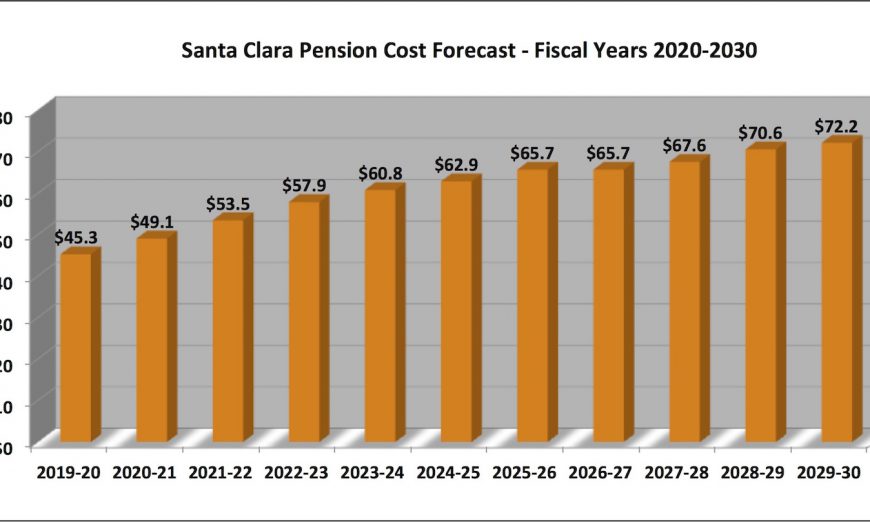At last month’s Santa Clara City Council goal-setting sessions the City’s finances were a principal subject of discussion, as well as central to the reports given by each City department at the meetings.
The Good News…
The City’s budget stabilization reserves have increased significantly and are on track to grow to $78 million this year, according to City Manager Deanna Santana, from $63 million in 2018. All City reserve accounts are funded by one-time money, said Finance Director Angela Kraetch.
More good news is that the City has also managed to corral a previously anticipated deficit this year. The deficits are now pushed out two years. However, deficits are still on the horizon in 2021-22 ($1.6 million) and 2022-23 ($0.5 million). For most of the next 10 years the City will see general fund surpluses between about $1 million and $3 million.
The budget forecast includes an economic slowdown in the next few years. However, if that slowdown is another recession, the deficits could grow to $6.9 million in 2020-21, $5.8 million in 2012-22, $2.6 million in 2022-23 and $0.9 million in 2023-24.
“We have made great progress and made some corrective forecast adjustments,” said Kraetch. “You will see those huge negatives that we have predicted in the last two years and we have self-corrected a lot of them by changing our accounting.”
Kraetch also noted that residents will see a new budget format for 2019-20, which will include more detail and be easier to read and understand.
The City anticipates only “modest” increases in next year’s budget to maintain current service levels, she said, and no big new capital projects will be introduced next year. Instead the focus will be on projects that are already planned or under way, and those that address “health and safety issues” and “serious deferred maintenance,” said Kraetch.
Unlike the past, this year’s budgeting won’t begin with a status quo budget from last year.
…And the Not-So-Good
The problems facing the City financially remain significant.
“We have a lot of unfunded projects and infrastructure,” Kraetch told the Council. “We don’t have a way to address these long-term and short-term needs.” These needs include the deteriorating half-century old International Swim Center and aging street surfaces and storm drains.
While costs and needs rise steadily, the City remains dependent on two volatile revenue streams: business-to-business sales tax generated by tech companies and hotel tax — together 31 percent of general fund revenue — that are highly dependent on economic conditions. Both were flat last year. These taxes closely track economic conditions while property tax tends to be more stable.
Property tax — which for the first time this year outpaced sales tax — combined with sales and hotel taxes comprise 55 percent of Santa Clara’s general fund revenue, said Kraetch.
Pension Bite Continues to Grow
In addition to unfunded needed infrastructure, Santa Clara faces another funding challenge: the City’s unfunded pension liability — at $516 million it’s about two-thirds of the City’s entire operating budget of $861 million — and inexorably growing pension costs.
Last year the state pension fund CalPERS set a limit of 10 years for agencies to pay up their unfunded pension liabilities. This year the fund has reduced its forecast rate of return. Both accelerated payback and lower returns mean higher payments for the City.
“PERS charges us a fixed cost,” to repay the debt, said Kraetch. “By 2029-30, our fixed cost will reach $71 million for miscellaneous [employees] and $32 million for safety [employees].” The rate of growth averages about $2 million a year over the next decade.
“We are making good progress,” she continued. “We did open the trust [fund to make up the unfunded liability]…[and]… we are putting money into that. It’s not a lot of money, but we are making much more progress than others.” Currently Santa Clara has $20.42 million in the trust account, said Kraetch.
Most of the unfunded liability isn’t for active employees, Kraetch explained. Roughly 65 percent of Santa Clara’s pension liability is for those already retired. Thus, although 65 percent of new City employees are in CalPERS post-2013 plan, PEPRA, that won’t make much difference in the City’s cost to pay down the unfunded liability.
Paying The Bills: New Taxes, Bond, Fees and Builder Contributions Under Consideration
The Council will be considering a variety of ways to increase revenue to close the budget gap and meet infrastructure and operating needs. One is a parcel tax (an additional property tax), which would have to be approved by voters, possibly in 2020.
Others include a 1 percent hotel tax increase — which Kraetch says would cover the projected deficits — a new tax on utility bills (Utility User Tax), fee and business tax increases, impact fee increases, and requiring developers to contribute additional public amenities and mitigations.
As salaries and benefits make up almost 75 percent of the City’s general fund expenses, there isn’t a painless way to cut expenses. “If we talk about reducing costs, it’s hard to talk about that without cutting services.”
You can find the agenda, presentations, video and transcripts from the Council’s goal-setting meeting at santaclara.legistar.com/Calendar.aspx






